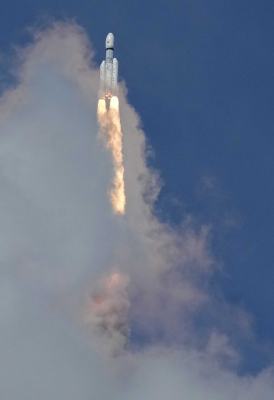
ISRO's Launch Vehicle Mark-III (LVM3) M4 rocket carrying 'Chandrayaan-3' lifts off from the launch pad at Satish Dhawan Space Centre, in Sriharikota, Friday, July 14, 2023. A PTI Photo
CHENNAI (PTI): Scientists at the Indian Space Research Organisation have successfully performed the first orbit raising manoeuvre of the Chandrayaan-3 spacecraft, the space agency said.
The health of the spacecraft was "normal", ISRO said last Saturday, in a social media post.
Chandrayaan-3 is now in an orbit, which when closest to Earth is at 173 kilometres and farthest from Earth is at 41,762 km.
"Chandrayaan-3 Mission update: The spacecraft's health is normal. The first orbit raising manoeuvre (Earthbound firing-1) was successfully performed at ISTRAC/ISRO, Bengaluru. Spacecraft is now in 41762kms x 173kms orbit," Bengaluru-headquartered ISRO said and shared the image of the spacecraft that is expected to make several manoeuvres ahead of its final descent to land on the south pole of the Moon.
ISRO, on July 14, successfully launched the third edition of its lunar exploration programme from the Satish Dhawan Space Centre, Sriharikota, aimed at making a soft landing on the unexplored south pole of the Moon that would help India achieve a rare feat.
Only three countries -- the United States, China and Russia -- have managed to land on the lunar surface so far.
Earlier in the day, Director of Vikram Sarabhai Space Centre S Unnikrishnan Nair said scientists at ISRO Telemetry, Tracking and Command Network (ISTRAC), Bengaluru would be engaged in the firing of the onboard thrusters attached to Chandrayaan-3 from Saturday onwards, taking the spacecraft further away from Earth on a crucial 41-day phase to make the soft landing on Moon.
"Today onwards, the onboard thrusters will be fired and Chandrayaan-3 will be taken away from Earth for an eventful landing on Moon's surface on August 23," Nair said.
"The vehicle system has performed extremely well. Because of that, whatever the initial conditions the spacecraft needed, we have provided very precisely," he told reporters in Thiruvananthapuram.
Following the successful launch of LVM3-M4 rocket carrying Chandrayaan -3, its project director P Veeramuthuvel had said on Friday that ISRO would be closely monitoring and controlling the spacecraft from ISTRAC.
"Many critical events are lined up, starting from Earth-bound manoeuvres, insertion into lunar orbit and separation of lander, a set of deboost manoeuvres, and finally the power descent phase for a soft landing (on the lunar surface)," Veeramuthuvel said.
 Previous Article
Previous Article Next Article
Next Article












The Indian Air Force, in its flight trials evaluation report submitted before the Defence Ministry l..
view articleAn insight into the Medium Multi-Role Combat Aircraft competition...
view articleSky enthusiasts can now spot the International Space Station (ISS) commanded by Indian-American astr..
view article